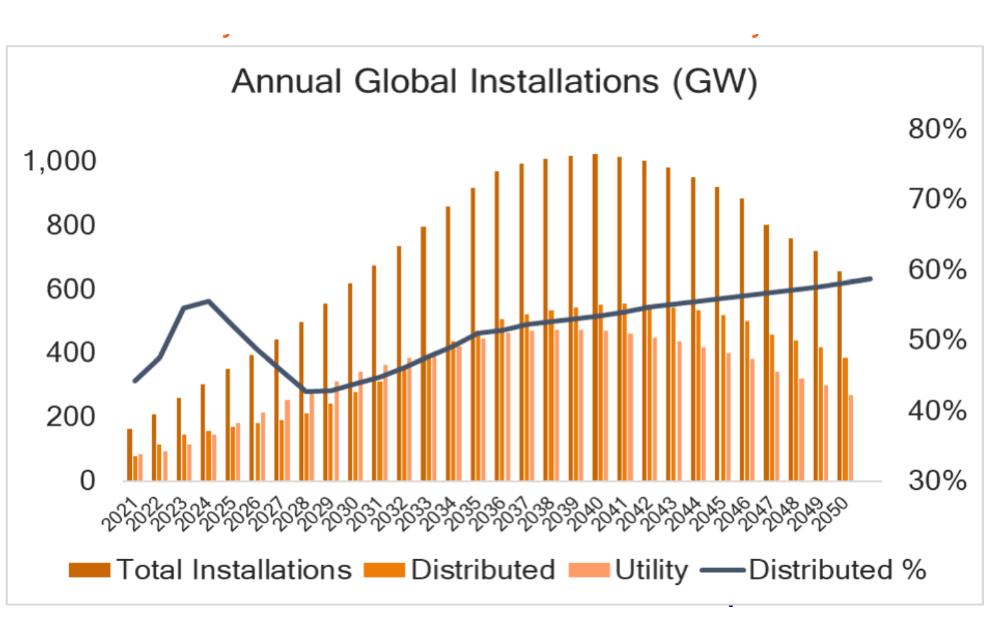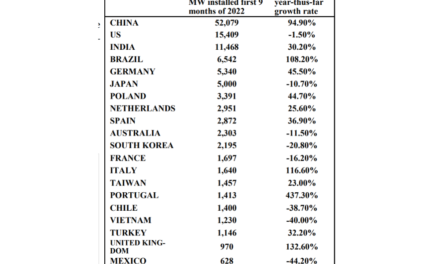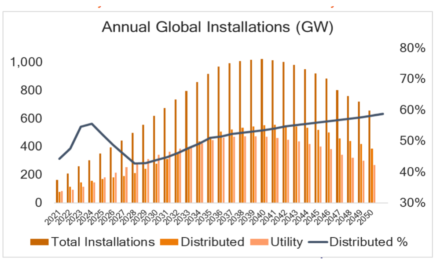- Rethink Energy’s new report predicts global installed cumulative solar PV capacity reaching 22.9 TW by 2050
- By 2036, utility scale installations will peak at 450 GW, followed by distributed solar at 618 GW by 2042
- Polysilicon prices will go back to below $10.0 per kg in the next 5 years as more capacity comes online thereby bringing down module and overall project costs
- Hydrogen electrolyzer capacity by 2050 will reach 4,754 GW and will be powered by 7 TW solar and 2.7 TW wind power
Come 2050, and the world will see its cumulative installed solar PV capacity growing to 22.9 TW led by China, the Indian sub-continent, US and Canada, Europe, and Latin America, with over 1 TW peak installation rate sustained through 2038 to 2041, estimates Rethink Energy.
In a new report titled Global Solar Forecast 2050, Rethink Energy of Rethink Technology Research expect annual solar installations globally to increase from 162 GW in 2021 to 351 GW in 2025 and 625 GW in 2030.
It would need 7 TW of solar and 2.7 TW wind power to power 4,754 GW of hydrogen electrolyzers by 2050, thanks to growing advancements in solar and batteries. Of the total global capacity of electrolyzers, 15% will be located across Chile and Australia. These 2 nations alone will have 1,063 GW solar power to electrify this technology.
Markets that are likely to reach their peak installation years around 2030 will be Japan, South Korea, Taiwan, the Netherlands and Belgium. Russia, India, Iran, Indonesia, several small Latin American states and Sub-Saharan Africa, excluding South Africa, will be the only ones to continue to grow by 2050.
Utility scale installations are likely to peak at 450 GW in 2036, and distributed solar by 2042 with 618 GW.
According to the report, “Distributed solar will surge above 60% of new additions in the next few years, due to several factors – partly the supply chain issues which have elevated modules prices to levels last seen in 2017 and 2018, but also the immediate response the rooftop sector will make to high electricity prices, especially in Europe and other Western countries.”
The Rethink analysts see the world’s solar PV module manufacturing capacity reaching 624 GW by 2030 including all the proposed capacity coming online and expecting it to run at 64% capacity utilization. They explain, “It is the 3 million tons of proposed polysilicon capacity—probably 4 million by now—which is the most significant here, and which should inform everyone’s view of the future scale of the solar industry.”
At the end of March 2022, total investments announced for polysilicon were a total of RMB 260 billion ($39 billion) with half of these coming from companies with no prior experience of polysilicon.
“This is why we say 4 million tons of capacity has been announced, but expect 2025 to see only 2.5 million tons built – expect some bankruptcies as well,” reads the report.
The good news is in another 5 years, Rethink expects polysilicon prices to go back to below $10.0 per kg due to overcapacity, on par with 2020 prices once the new capacity comes online and ends the current shortage. Since polysilicon accounts for 41% of the finished module price, it would make modules 20% cheaper from the current prices, and utility scale projects 8% cheaper to build.

Till March 2022, global investments proposed for polysilicon added up to RMB 260 billion ($36 billion) which Rethink analysts count as adding up to 4 million tons. But it expects only 2.5 million tons to be built by 2025. (Source: Rethink Research)
However, granular polysilicon produced through the fluidized-bed reactor (FBR) process reduces its electricity consumption to 15-30 kWh per kg, down by 2/3rd the new break-even price will be $6 per kWh. While the Siemens process, currently more popularly used, needs 55 kWh electricity per kWh now, FBR’s downside its that it uses more water. At present, only GCL Poly uses FBR technology to produce granular silicon, while European makers don’t plan to use any ‘unless and until Western governments adopt a full-spectrum solar manufacturing strategy with billions of subsidies involved’.
As the world moves forward, PERC will give way to TOPCon, followed by heterojunction (HJT) and tandem designs, finally perovskite. HJT will exceed 10% market share by 2025. According to the report, non-Si and tandem PV will account for 10% of global market share in terms of production capacity by 2029 thanks mainly to First Solar, and reach 50% in 2041, eventually 78% in 2050.
In February 2021, Rethink predicted global perovskite solar manufacturing capacity to reach 117 GW by 2030 (see Solar’s Future Bright With Perovskite?). Over a year down the line, the analysts are not so sure as the technology still needs to match the 30-year warranty of mainstream solar. Expect this technology to come into widespread use by 2030.
Tandems are quicker to come up instead. It sees the world’s 1st commercially available tandem cell to have silicon combined with First Solar’s Cadmium Telluride (CdTe) coming out by 2024 ‘with current matching only at the module level’. Analysts see tandems reaching up to 15 GW production output by 2030, and other non-silicon photovoltaics, mostly CdTe at 68 GW.
Analysts also see solar repowering industry, including replacement of modules and/or inverters in existing installations with cheaper ones, to 1 GW per annum by 2026.
Detailed report can be accessed on Rethink Research’s website.















